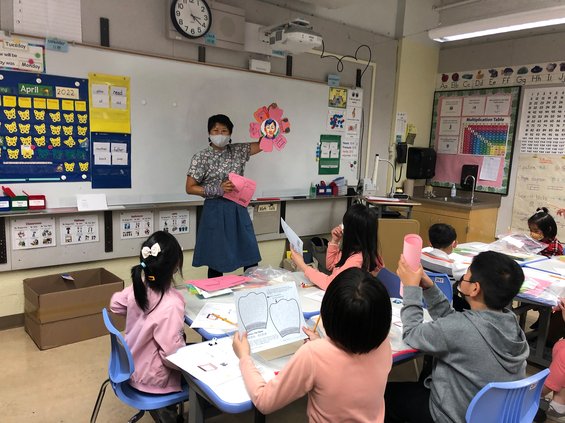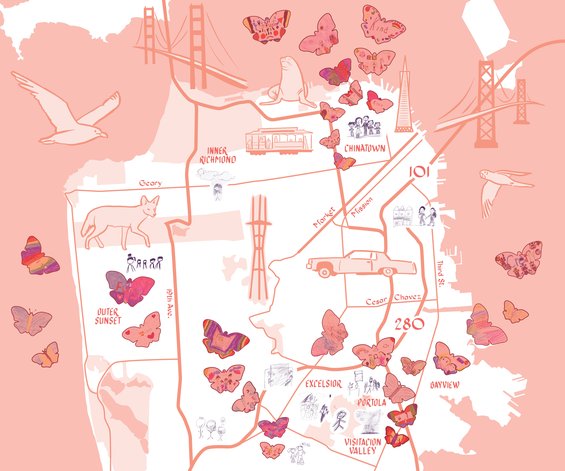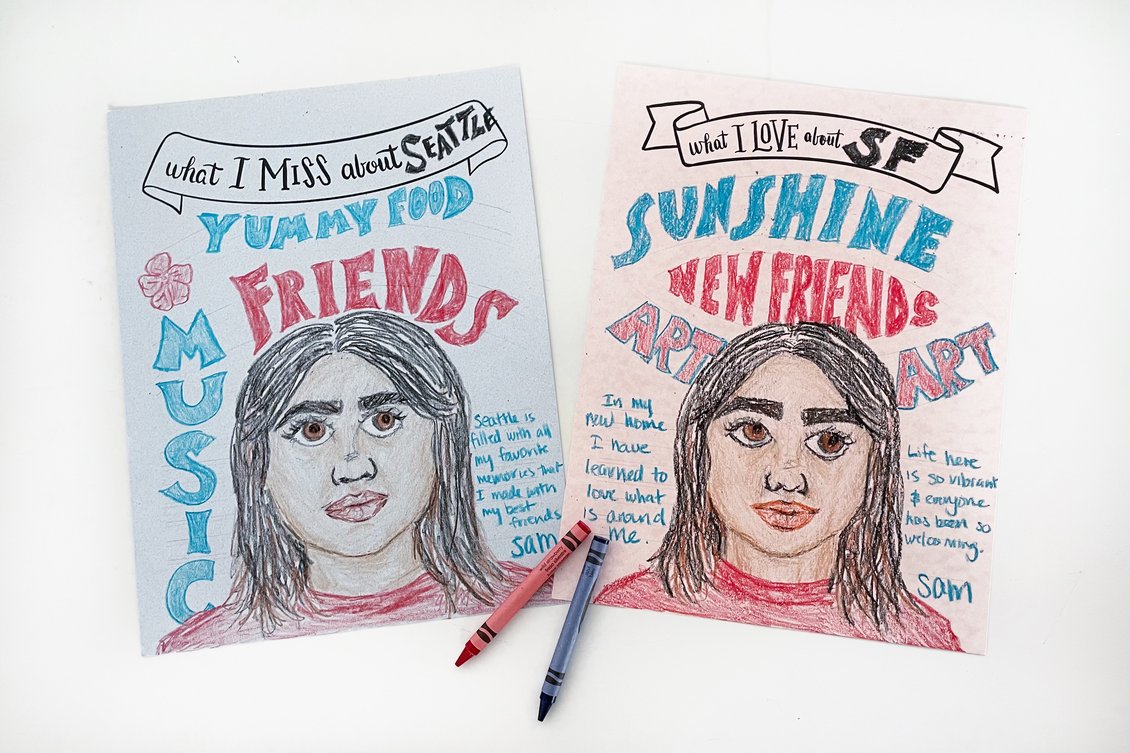What does "home" mean to you?
This teaching module is designed to accompany CCA class visits to Recognitions / 认 • 知, a solo exhibition by CCA alum Christine Wong Yap (BFA Printmaking 1998, MFA Printmaking 2007). Recognitions / 认 • 知 is on view at CCA Campus Gallery Wednesday 11am–7pm, Thursday–Friday 11am–4pm, and by appointment, January 25–March 17, 2023.
Recognitions / 认 • 知 features three new projects on the topic of belonging that mark the culmination of a collaborative social practice project between Christine and the Edwin and Anita Lee Newcomer School (EALNS)—a public, one-year, language immersion elementary school in San Francisco’s Chinatown, serving Chinese-speaking recent immigrants.

To explore the concept of belonging with students at EALNS, Christine crafted prompts for K–5 students that were presented in a series of in-person, hands-on workshops at an after school program, including: What does “home” mean to you? What’s something you miss about your country of origin? What’s something you love about living in California? What is a positive adjective you would use to describe yourself? These questions offer the opportunity to reflect upon and share their feelings about migration and their adjustment to San Francisco, while reinforcing the social-emotional learning focus of EALNS, which is distinct from the rote learning method more commonly found in schools in China.
“Moving is a stressful life event,” says Christine Wong Yap. “In addition to the stress of moving, the EALNS students migrated to a new country as English-language learners during a pandemic amidst rising anti-Asian sentiment. By recognizing these children, their stories and artworks, and the validity of their feelings, this exhibition attempts to welcome them and their fellow newcomers to San Francisco and shine a light on their journeys toward belonging.”
Christine's project investigates belonging through the lens of children who have immigrated to the United States in the past year, but her questions feel pertinent across every kind of major life change. Immigration and other transitions can be a process of total uprooting—it can feel as though one loses their sense of belonging—and with that comes feelings of loss, grief, excitement, or anxiety. This feeling of belonging, being in community with others, is integral to our well-being, making it especially important in these transitions.
Christine Wong Yap (she/they) is a visual artist and social practitioner working in community engagement, drawing, printmaking, publishing, and public art to explore psychological well-being, belonging, and resilience. Through her socially-engaged art practice, she seeks to imagine a more hopeful and inclusive world by empowering communities from within and bridging culturally-diverse communities.
Key Terms
Belonging
Belonging is something that is intentionally difficult to capture in words. Belonging is the feeling of being seen, a sense of comfort in a space or with others. A sense of belonging brings people together and has the power to build bridges across diverse individuals and communities.
"After an individual’s basic needs are met, the door is opened to experience a sense of belonging. Belonging cultivates feelings that the individual matters, they are valued, they feel safety, and it is conveyed that they are indispensable to the group. A sense of belonging is relational, reciprocal, and dynamic." -Tricia Brand, Vice President of DEIB
AAPI: Asian American and Pacific Islander
Many people who are considered to fit under the wider identity category of ‘Asian’ do not often feel recognized under the label ‘Asian-American.’ Additionally, the term ‘Asian-American’ often marginalizes ethnic subgroups as it tends to be most strongly associated with light-skinned, wealthy west Asians. This leads to invisibility and disparity within the community. AAPI represents a more inclusive label that recognizes both the diversity and disparities experienced within the larger Asian diasporic community.
- For further reading: Li Zhou, “The Inadequacy of the Term Asian American,” Vox.
Socially-engaged practice/social practitioner
Christine Wong Yap describes herself as a "social practitioner." This means that her art works directly with social issues at their root, which involves working directly with the community. Her art creates real change by affecting real people, making it even more impactful.

- For discussion: What is the impact of combining art with social activism?
Grassroots Activism
“Grassroots activism is when ordinary people take actions meant to demonstrate public opinion or demands and spark political change. This type of activism often originates among impacted communities and is characterized by a bottom-up decision-making process as well as a horizontal organizing model.” (Jasper, Street Civics)
- For discussion: What is the importance of grassroots activism to enacting change?
- For further reading: Dan Jasper, “Grassroots Activism and How It REALLY Works,” Street Civics
Conversation Prompts
Please consider these questions as you move through the exhibition:
- How can you foster community-specific wellness and belonging in new places?
- Where do you feel belonging? What do those spaces look/feel like?
- What things (food, smells, objects, clothes, people, etc.) remind you of a sense of comfort/home/belonging?
Activity

Two activity sheets that Christine designed for Edwin and Anita Lee Newcomer School encourage students to reflect on what gave them a sense of belonging before they moved to the Bay Area, and what they love about where they currently live.
- First, draw a self-portrait in the head and shoulders outline of the activity sheet.
- Think of a place that you miss. Write its name in the space in the banner.
- Think of things you miss about that place. Write them in the arched lines in the middle of the page. Be as creative as you like with the lettering.
- Write why you miss that place in the straight lines. Or, translate what you miss about the place into your native language. Then, write your name on the lowest line on the right.
"What I miss" activity sheet ➞
- Draw a self-portrait in the head and shoulders outline of the activity sheet.
- Think of a place where you are currently living, which you love. Write its name in the space in the banner. For example, you might name your school, neighborhood, city, or state.
- Think of things you love about that place. Write them in the lines in the middle of the page. Be as creative as you like with the lettering.
- Write why you love that place in the straight lines on the sides of the portrait. Or, translate what you love about the place into your native language and write it instead. Then, write your name on the lowest line on the right.
Local Resources
- Chinese Cultural Center (CCC) engages with both AAPI-specific wellness (like tai chi classes) and promotes/sustains Chinese specific arts and culture (ArtBuds and Annual Chinatown Music Festival)
- East Bay Asian Youth Center seeks to actively support AAPI youth in the East Bay through specific youth programs and advocating for a safer, more supportive social and physical environment as a means of community flourishing. It provides intensive, trauma-informed advisory services, school partnerships, and college/career readiness programs
- Through supporting AAPI women’s independence and self-sufficiency, Asian Women’s Shelter seeks to eliminate domestic violence and support those who have been victims of it. It operates as a shelter and crisis center, but also provides specific care for queer and trans Asian women, victims of sex trafficking, case management, as well as community building services (destigmization efforts, grassroots organizing, etc)
- Oakland Asian Cultural Center provides resources engaging both members of Oakland’s Black community and AAPI community for cross-cultural dialogue, cultural art/craft/activity classes (ikebana, taichi, calligraphy, etc.), and supporting exhibitions dealing with AAPI-centered issues
- Red Canary Song organizes and advocates for the rights of Asian and migrant sex workers
Header image: Hand lettering by Christine Wong Yap incorporating self-portraits by Jiapei, Celina, Ryan, and Steve, students at Edwin and Anita Lee Newcomer School in San Francisco’s Chinatown, 2022. 8.5 x 11 inches each.
Image 1: Christine Wong Yap leads an art workshop at Edwin and Anita Lee Newcomer School in San Francisco's Chinatown, 2022.
Image 2: Christine Wong Yap with contributors, Map of Young Newcomers’ Feelings of Home and Positive Qualities, 2022. Digital design with artworks by students at Edwin and Anita Lee Newcomer School, 96 x 115 inches.
Image 3: "What I miss" and "What I love" activity sheets designed by Christine Wong Yap, completed by Sam Hiura.
This teaching module was developed by Sam Hiura, Exhibitions Assistant.
